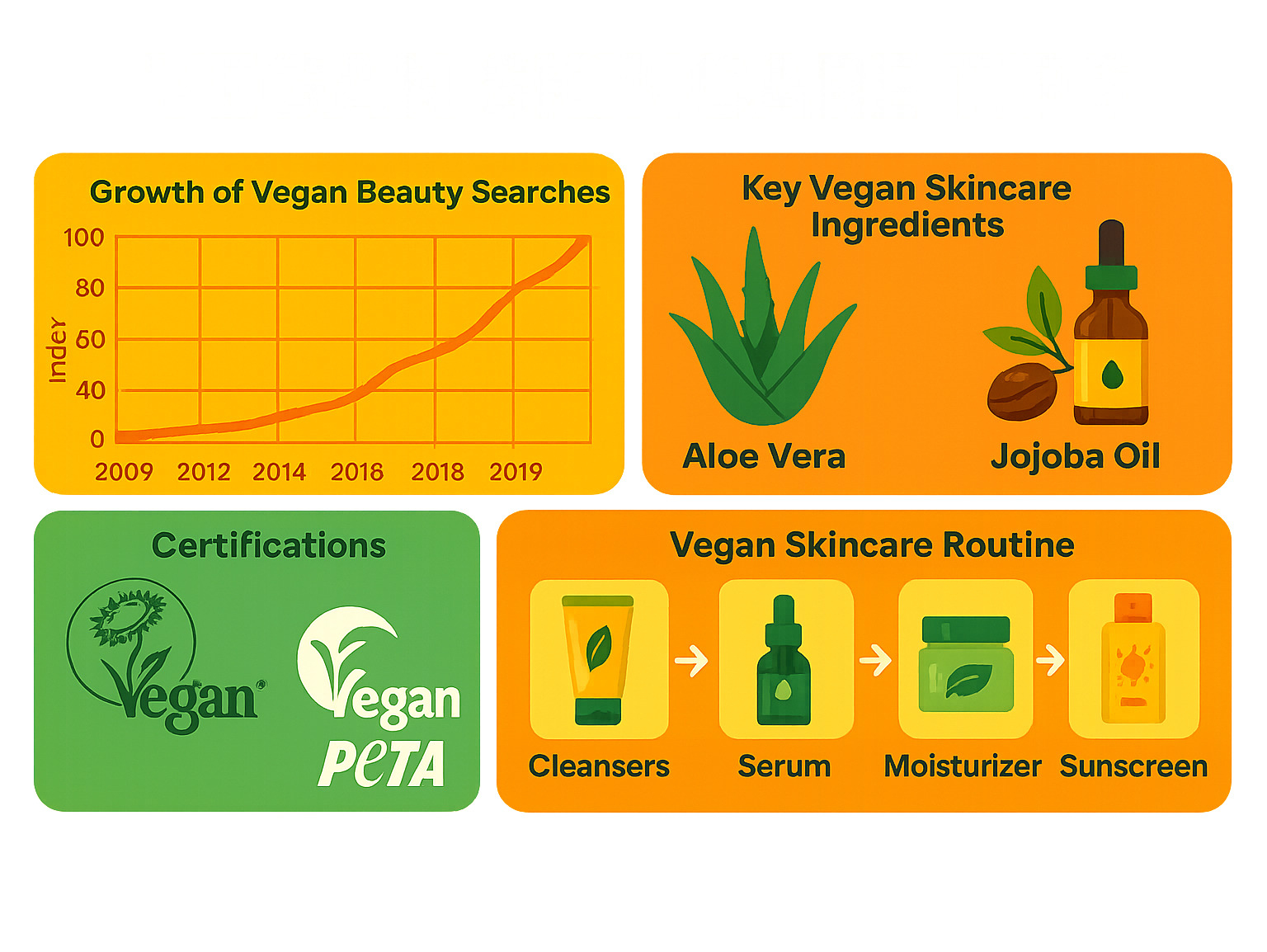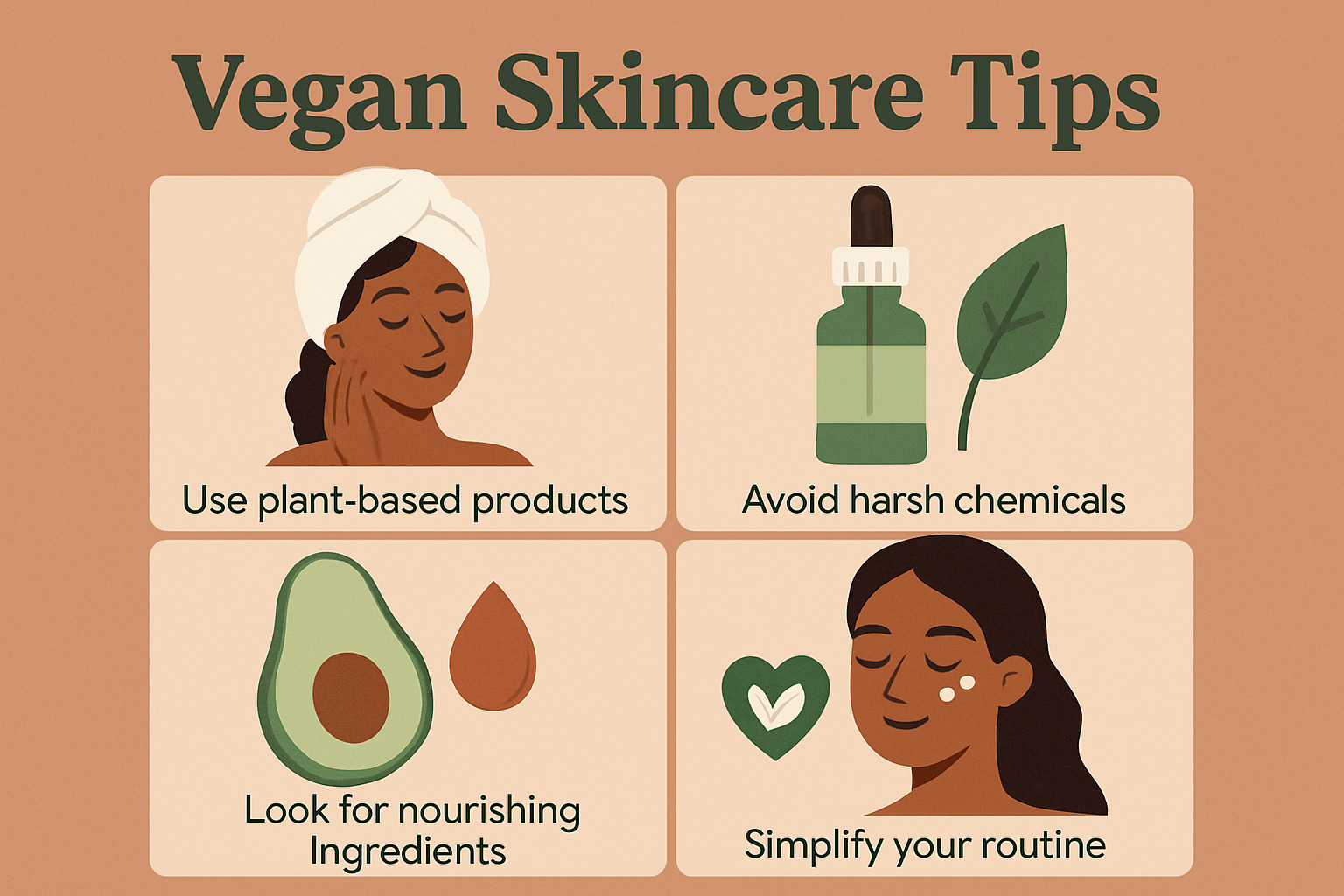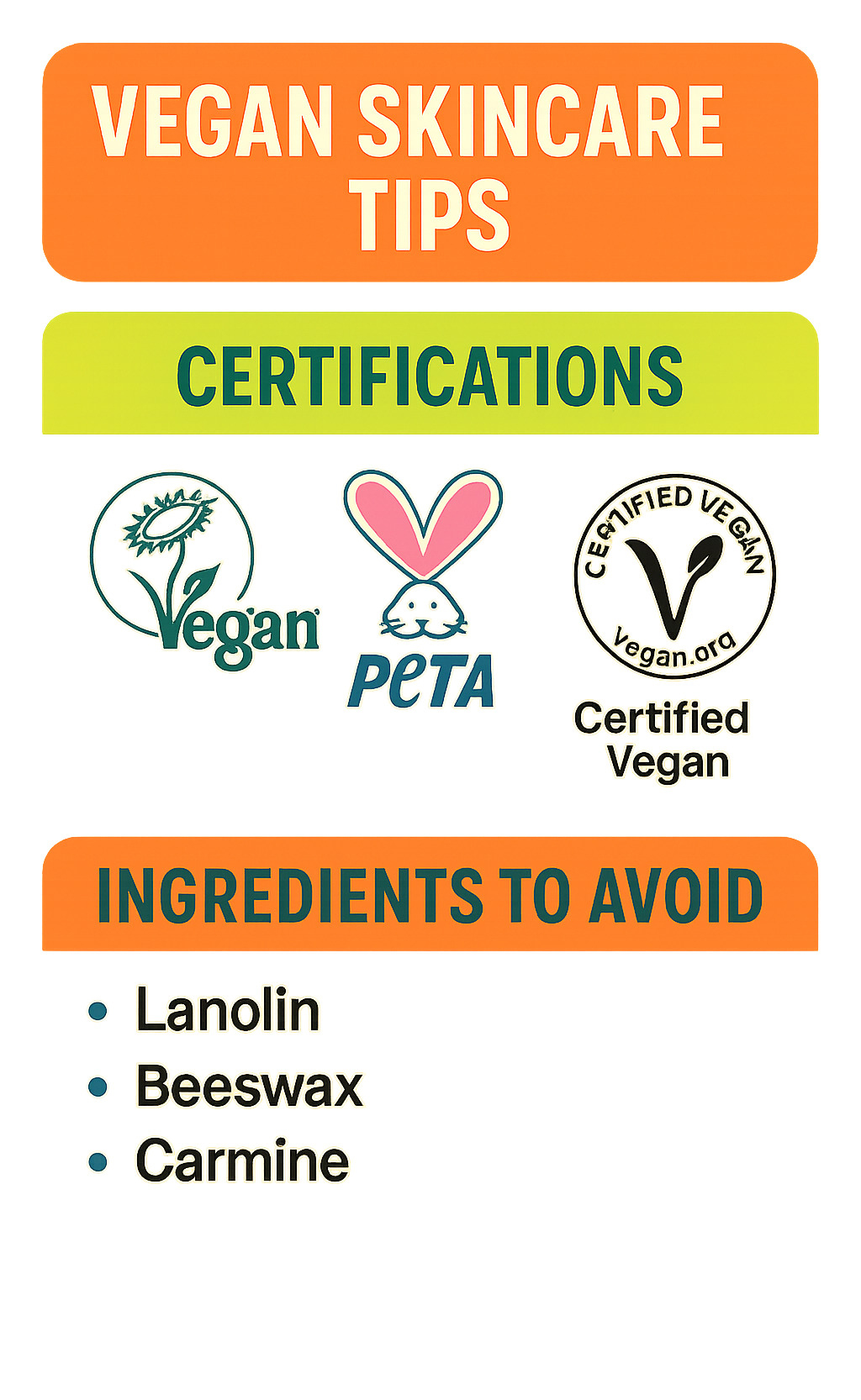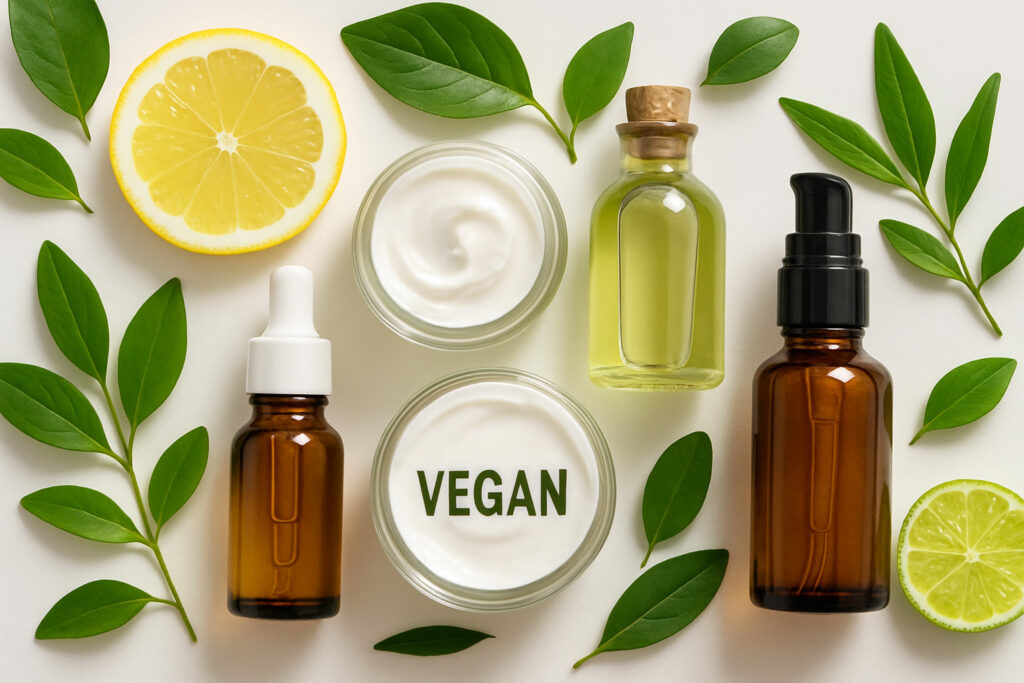Why Vegan Skincare is Changing Modern Beauty
Vegan skincare tips are becoming essential knowledge as more consumers seek ethical, effective beauty solutions. With a 445% increase in worldwide online searches for ‘vegan’ over the last decade, plant-based beauty has moved from niche to mainstream.
Quick Vegan Skincare Tips:
- Choose certified products – Look for Vegan Society or PETA logos
- Read ingredient lists – Avoid honey, beeswax, lanolin, and collagen
- Layer plant-based actives – Use antioxidant serums and botanical oils
- Support with diet – Eat omega-3 rich foods like flaxseeds and walnuts
- Pick mineral SPF – Zinc oxide and titanium dioxide are naturally vegan
- Hydrate inside and out – Drink water and use plant-based moisturizers
The shift toward vegan beauty isn’t just about avoiding animal ingredients. It’s about embracing plant-powered formulations that often contain fewer harsh chemicals and more skin-nourishing botanicals.
Whether you’re motivated by animal welfare, environmental impact, or simply want gentler skincare, this guide will help you steer vegan beauty with confidence.

Simple vegan skincare tips word guide:
Why read this guide?
We’ve distilled years of beauty expertise into actionable vegan skincare tips that you can implement immediately. This comprehensive guide covers everything from decoding ingredient labels to building routines that work for your skin type.
By the end, you’ll understand how to identify truly vegan products, avoid common pitfalls, and create a routine that supports both your skin health and ethical values.
Understanding Vegan vs. Cruelty-Free Beauty
The beauty world can feel confusing with labels like “vegan,” “cruelty-free,” and “natural” splashed across every product. But vegan and cruelty-free aren’t the same thing, even though they’re often bundled together on packaging.
Think of it this way: vegan skincare is about what goes into your products, while cruelty-free is about what doesn’t happen during testing. You could have a vegan moisturizer that was tested on animals, or a cruelty-free serum that contains beeswax.
Understanding these distinctions becomes one of the most important vegan skincare tips when you’re starting your clean beauty journey.
| Aspect | Vegan | Cruelty-Free |
|---|---|---|
| Animal ingredients | None allowed | May contain |
| Animal testing | May occur | Never occurs |
| Certification | Vegan Society, Certified Vegan | Leaping Bunny, PETA |
| Focus | Ingredient sourcing | Testing practices |
The overlap happens when brands commit to both standards – no animal ingredients and no animal testing. These are the gold-star products that tick all the ethical boxes.
What makes skincare “vegan”?
For a product to earn the vegan label, every single ingredient must come from plants, minerals, or synthetic sources – no exceptions. This sounds straightforward until you realize how many sneaky animal-derived ingredients hide in everyday skincare.
Lanolin might sound harmless, but it’s extracted from sheep’s wool. Carmine gives products that pretty red tint, but it comes from crushed beetles. Even cholesterol in anti-aging cream might be sourced from animal tissue rather than plants.
The challenge comes with ingredients that can swing both ways. Glycerin can come from vegetable oils or animal fats, and there’s no way to tell just by reading the ingredient list. Squalene might be derived from olives or shark liver oil.
When brands display the Vegan Society trademark or Certified Vegan logo, they’ve done the homework for you. These organizations verify that every ingredient meets vegan standards.
How is “cruelty-free” different?
Cruelty-free certification focuses on testing practices, ensuring no animals were harmed during product development.
The Leaping Bunny certification sets the gold standard by monitoring the entire supply chain. PETA’s cruelty-free program offers another trusted certification with slightly different requirements.
The tricky part comes with regulatory loopholes. Some brands claim to be cruelty-free while selling in markets where animal testing is legally required. This is why looking for official certifications, rather than just brand claims, becomes so important.
When building your vegan skincare tips toolkit, the most ethical approach often means seeking products that are both vegan and cruelty-free.
Why Switch: Skin, Animals & Planet
Making the switch to vegan skincare isn’t just about following a trend – it’s about embracing a beauty approach that benefits your skin, protects animals, and supports our planet.
Evidence-backed skin benefits
Your skin loves plant-based ingredients, and science backs this up. Scientific research on plant antioxidants shows these natural powerhouses deliver vitamins, minerals, and protective compounds that synthetic alternatives often can’t match.
Plants have spent millions of years developing sophisticated defense systems against environmental damage. When you apply vitamin C from rosehip or antioxidants from green tea to your skin, you’re borrowing nature’s own protection strategies.
Plant-based formulations work differently than conventional products. Omega fatty acids from sea buckthorn reduce inflammation and strengthen your skin’s natural barrier. Minerals from algae and clay actively detoxify while delivering essential nutrients.
Vegan skincare is particularly gentle because it naturally avoids many common irritants. No lanolin (which can trigger allergic reactions), no harsh animal-derived ingredients that might sensitize delicate skin. Instead, you get fewer sensitizers and more skin-loving botanicals that work in harmony with your natural healing processes.
The bigger impact
Every time you choose a vegan skincare product, you’re casting a vote for a more sustainable world. Animal agriculture produces significant greenhouse gases that contribute to climate change. By supporting plant-based beauty, you’re helping reduce demand for these environmentally costly ingredients.
Latest data on vegan trends reveals sustained consumer interest, with vegan beauty now representing one of the fastest-growing segments in the beauty industry.
This means reduced water usage in ingredient production, a lower carbon footprint from plant cultivation, and decreased packaging waste as innovative brands develop plant-based containers.
Choosing vegan skincare supports biodiversity. When brands source botanical ingredients responsibly, they’re supporting diverse ecosystems rather than monoculture approaches.
The Vegan Society’s Vegan Trademark now certifies over 65,000+ cosmetics, giving you unprecedented choice in ethical beauty options. Your skincare routine becomes part of a movement toward ethical living that considers the carbon footprint of every product choice while delivering effective, gentle results.
Essential Vegan Skincare Tips & Routine
Building an effective vegan skincare routine doesn’t require a complete overhaul. The fundamentals remain the same – cleanse, treat, and protect – but now you’re choosing plant-powered products that work beautifully with your skin while staying true to your values.
The magic happens when you layer compatible botanical ingredients in the right order. Whether you’re dealing with an oily T-zone, parched winter skin, or sensitivity issues, there are vegan skincare tips that can transform your routine.

Morning vegan skincare tips
Your morning routine is like putting on armor for the day ahead. You want to protect and prepare your skin for whatever the world throws at it.
Start with a gentle cleanser that won’t strip away your skin’s natural protective oils. Look for plant-based formulas with soothing ingredients like aloe vera and chamomile.
Next comes your antioxidant serum – think of this as your daily vitamin for your face. Plant-derived vitamin C from sources like kakadu plum works overtime to protect against environmental damage while supporting collagen production.
Follow with a lightweight moisturizer that won’t compete with your makeup. Ingredients like jojoba oil or shea butter provide hydration without heaviness.
The final step is non-negotiable: mineral SPF. Zinc oxide and titanium dioxide are naturally vegan minerals that provide excellent broad-spectrum protection.
Evening vegan skincare tips
Evening is when the real magic happens. Your skin goes into repair mode while you sleep, so this is your chance to give it the good stuff.
Double cleansing is one of the best vegan skincare tips you can adopt. Start with a plant-based cleansing oil to melt away makeup and SPF. Follow with a gentle water-based cleanser.
This is when you can introduce more intensive treatments. Plant-derived retinol alternatives like bakuchiol or niacinamide serums work beautifully in evening routines.
Finish with a richer night moisturizer that can work undisturbed while you sleep. Ingredients like plant ceramides and botanical oils help repair and strengthen your skin barrier overnight.
Customising for oily, dry, sensitive skin
Oily skin loves lightweight, gel-based textures. Tea tree oil and willow bark can help control excess oil without overdrying. Niacinamide is fantastic for regulating oil production.
Dry skin craves rich, nourishing formulas. Layer hydrating toners with glycerin and botanical extracts, then seal everything in with moisturizers containing plant ceramides. Facial oils like rosehip or argan can be game-changers.
Sensitive skin needs a gentle approach. Look for fragrance-free formulations with minimal ingredient lists. Chamomile, calendula, and oat extract are soothing botanicals that calm irritation.
The key to success is consistency. These plant-based ingredients work best when used regularly. Start slowly and give your skin time to adjust to its new botanical friends.
Reading Labels & Spotting Certifications
Learning to read beauty labels might seem daunting at first, but it’s honestly one of the most empowering vegan skincare tips you’ll ever master. Think of it as becoming a beauty detective – once you know what clues to look for, you’ll spot truly vegan products with confidence.
The beauty industry loves its scientific names and marketing speak, which can make ingredient lists look like chemistry homework. But here’s the thing: you don’t need a science degree to make smart choices. You just need to know the key players and red flags.

Certifications that matter
Third-party certifications are like having a trusted friend vouch for a product. These organizations do the heavy lifting of investigating supply chains, auditing facilities, and verifying claims so you don’t have to.
The Vegan Society Trademark is the gold standard – it’s been around since 1944 and has strict requirements covering everything from ingredients to manufacturing processes. When you see their sunflower logo, you can trust that no animal products or by-products were used.
Certified Vegan takes a similarly rigorous approach, conducting thorough verification processes that examine not just the final product but the entire production chain. Their logo features a simple “V” that’s easy to spot on packaging.
PETA’s cruelty-free bunny logo focuses specifically on testing practices rather than ingredients, so while it guarantees no animal testing occurred, it doesn’t necessarily mean the product is vegan. It’s still valuable information, just addressing a different ethical concern.
Here’s what makes these certifications worth looking for: they provide legal protection for consumers, ensure supply chain transparency, and require regular auditing to maintain compliance. The visual logos make it easy to identify certified products at a glance.
That said, not every fantastic vegan brand carries certifications. Some smaller companies can’t afford the fees or administrative burden, while others are in the process of obtaining certification. When in doubt, don’t hesitate to reach out to brands directly – most are happy to share details about their ingredient sourcing and vegan status.
Red-flag ingredients to avoid
Some non-vegan ingredients are obvious (like honey), while others hide behind scientific names that would stump most people. The trickiest part? Many ingredients can be sourced from either plants or animals, depending on the manufacturer’s choice.
Let’s start with the always-animal-derived ingredients you should definitely avoid. Lanolin comes from sheep’s wool and pops up frequently in lip balms and rich moisturizers. Carmine (sometimes listed as cochineal) creates beautiful red pigments but comes from crushed beetles – definitely not vegan-friendly.
Beeswax appears in countless beauty products as a natural emulsifier and texture improver, but it’s obviously off-limits for vegan skincare. Similarly, silk powder might sound luxurious, but it’s derived from silkworm cocoons.
The more challenging category includes ingredients that could go either way. Glycerin is everywhere in skincare because it’s an excellent humectant, but it can be derived from either plant oils or animal fats. Most modern cosmetics use plant-derived glycerin, but it’s worth checking with the brand to be sure.
Squalane has an interesting history – it was originally sourced from shark liver oil, which led to significant environmental concerns. Thankfully, most beauty brands now use plant-derived squalane from olives or sugarcane, but again, verification doesn’t hurt.
Stearic acid appears in many cream formulations as an emulsifier and can come from either plant or animal sources. The same goes for lecithin, which is usually soy-based but can occasionally be animal-derived.
When you encounter these ambiguous ingredients, a quick email to the brand’s customer service team usually clears things up. Most companies are transparent about their sourcing and happy to help conscious consumers make informed choices.
The Leaping Bunny organization offers comprehensive resources for understanding ingredient origins and maintaining up-to-date lists of certified brands, making your vegan beauty journey much easier to steer.
Beyond Products: Lifestyle, Diet & Sustainability
The best vegan skincare tips go far beyond what you put on your face. Your daily habits, food choices, and environmental practices all play starring roles in your skin’s health story.
Diet-based vegan skincare tips
Your breakfast choices can be just as important as your serum selection. Plant-based diets naturally provide the antioxidants, vitamins, and healthy fats that your skin craves from the inside out.
Omega-3 fatty acids from flaxseeds, chia seeds, and walnuts work like internal moisturizers, reducing inflammation and strengthening your skin’s protective barrier. Vitamin C from citrus fruits and berries acts as your body’s natural collagen factory.
Zinc from pumpkin seeds and legumes is your skin’s healing superhero, supporting wound repair and helping regulate oil production. Probiotics from fermented foods support gut health, which directly impacts skin clarity.
Research shows that eating colorful fruits and vegetables rich in antioxidants can dramatically improve skin texture. Blueberries contain antioxidants that help protect against free radical damage while supporting skin barrier repair.
Skin-supporting foods include carotenoid-rich tomatoes, dark chocolate (choose vegan varieties!), leafy greens packed with vitamins, and avocados loaded with healthy fats.
Sustainable habits for glowing skin
Sustainability and beautiful skin make perfect partners. Many eco-friendly practices actually benefit your complexion while reducing your environmental footprint.
Using lukewarm water instead of hot water for cleansing preserves your skin’s natural protective barrier. Concentrated formulas not only require less packaging but often deliver more potent results.
Choose refillable packaging when possible, and look for compostable cotton pads that break down naturally. Consider multi-purpose products that streamline your routine while reducing waste.
Remember to follow NHS advice on sun safety by applying mineral-based vegan sunscreens daily. Sun protection remains crucial, and mineral formulas with zinc oxide and titanium dioxide are naturally vegan and reef-safe.
Sustainable beauty habits often slow you down in the best possible way, creating more intentional, satisfying self-care experiences.
Frequently Asked Questions about Vegan Skincare
Let’s address the most common questions we hear about making the switch to plant-based beauty. These vegan skincare tips come from real experiences and expert insights to help you steer your journey with confidence.
Are vegan products always better for sensitive skin?
Here’s the honest truth: vegan doesn’t automatically mean gentler. While many plant-based formulations skip common irritants like lanolin (which can trigger allergic reactions), they might include potent botanical extracts or essential oils that sensitive skin finds challenging.
The real advantage of vegan skincare for sensitive types lies in transparency. Many vegan brands prioritize clean formulations with shorter ingredient lists, making it easier to identify potential triggers. You’ll often find gentle botanicals like chamomile, oat extract, and aloe vera taking center stage instead of synthetic alternatives.
Your best bet is reading every ingredient list carefully and patch-testing new products on your inner arm before full application. Some people actually tolerate well-researched animal-derived ingredients better than certain plant extracts – and that’s perfectly okay.
Look for fragrance-free vegan formulations specifically designed for sensitive skin. These typically feature minimal ingredients and avoid common plant-based irritants like citrus oils or strong botanical extracts.
How do I transition my entire beauty shelf?
Switching to vegan skincare doesn’t require throwing out your entire collection overnight. We recommend a thoughtful, gradual approach that respects both your budget and your skin’s adjustment period.
Start with your daily cleanser since it’s the foundation of any routine and gets used up relatively quickly. This gives you immediate experience with vegan formulations without overwhelming your skin with multiple new products at once.
Next, replace your treatment products like serums and targeted treatments as they run out. These often have the most dramatic impact on your skin, so finding the right vegan alternatives here is crucial. Follow with moisturizers and SPF, then gradually work through makeup and specialty items like eye creams.
This strategic timeline prevents waste while allowing you to properly test each new product. Keep notes on what works well – your future self will thank you when it’s time to repurchase. The transition typically takes 6-12 months, depending on how quickly you use products.
There’s no beauty police checking your medicine cabinet. Take the time you need to find vegan skincare tips and products that truly work for your unique skin.
Is vegan SPF as protective as conventional formulas?
Absolutely, and here’s why you can feel confident about plant-based sun protection. Mineral sunscreens using zinc oxide and titanium dioxide are naturally vegan and offer excellent broad-spectrum protection against both UVA and UVB rays.
These mineral ingredients sit on top of your skin, physically blocking harmful rays rather than absorbing them like chemical filters. Many dermatologists actually prefer mineral formulations because they’re less likely to cause irritation and start working immediately upon application.
Modern vegan sunscreens have come incredibly far from the thick, white formulas of the past. You’ll now find options with SPF 30 or higher (the dermatologist-recommended minimum), water resistance for active days, and even tinted versions that blend seamlessly into different skin tones.
Many vegan formulations also include antioxidant-rich botanical extracts like green tea or vitamin E, providing additional protection against environmental damage. The key to effective sun protection isn’t whether your SPF is vegan or conventional – it’s choosing a product with adequate protection and reapplying every two hours.
Trust the science: mineral-based vegan sunscreens protect just as effectively as any conventional formula when used properly.
Conclusion & Next Steps
Your journey into vegan skincare tips represents more than a simple product swap – it’s a beautiful alignment of your values with your daily self-care ritual. The plant-powered beauty world has evolved dramatically, offering sophisticated formulations that rival any conventional product while supporting your ethical choices.
Think of this transition as planting seeds for long-term skin health. Just as a garden flourishes with the right nutrients and care, your skin will respond to the vitamins, antioxidants, and gentle botanicals found in vegan formulations. The bonus? You’re also nurturing the planet and supporting cruelty-free practices with every purchase.
The most important lesson from our guide is that vegan beauty isn’t about perfection – it’s about progress. Whether you start by switching your cleanser or diving headfirst into a complete routine overhaul, every conscious choice matters. Your skin will thank you for the gentler ingredients, animals benefit from reduced demand for their byproducts, and the environment gains from more sustainable beauty practices.
Reading labels becomes second nature with practice. Those intimidating ingredient lists will soon feel familiar, and you’ll quickly spot the red flags we’ve discussed. The certified logos will become your trusted allies, making shopping faster and more confident.
Your lifestyle choices amplify everything you apply topically. That morning smoothie packed with antioxidant-rich berries works alongside your vitamin C serum. Your evening wind-down routine supports the repair work of your night cream. It’s all beautifully interconnected.
At Beyond Beauty Lab, we believe that true beauty radiates from informed choices that feel authentic to who you are. Our mission is supporting your wellness journey with practical, science-backed guidance that makes sense for real life.
Ready to expand your clean beauty knowledge even further? Our wellness library is packed with expert insights, holistic health tips, and curated resources that approach beauty from every angle. Because the best vegan skincare tips are just the beginning of a lifestyle that honors both your skin and your values.
Your conscious beauty story starts now. Trust the process, be patient with your skin’s adjustment period, and celebrate each small victory along the way. The glow you’re working toward isn’t just about appearance – it’s the confidence that comes from living in alignment with what matters most to you.








